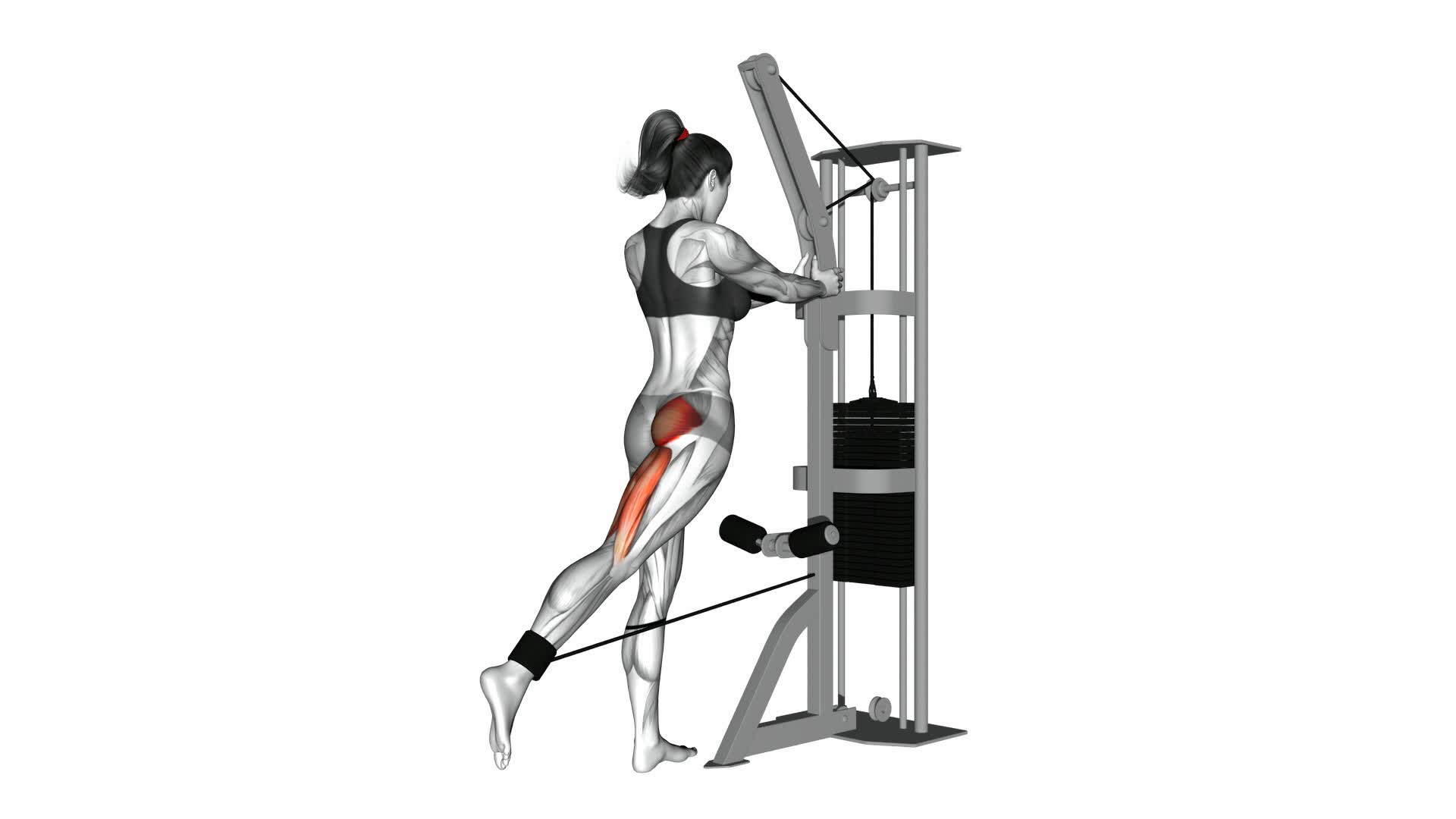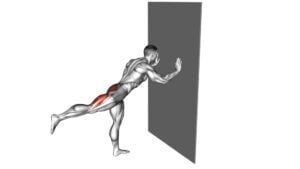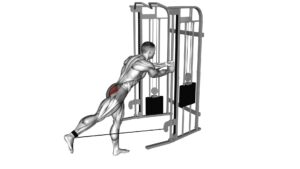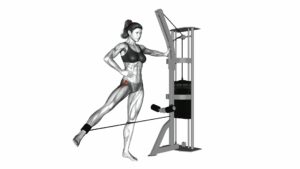Cable Standing Hip Extension (Version 2) – Video Exercise Guide & Tips

In this video exercise guide, you'll learn the proper technique for the cable standing hip extension (version 2). This exercise targets your glutes and hamstrings, helping to strengthen and tone your lower body.
Watch This Exercise Video
With the right equipment and setup, you'll be able to perform this exercise with ease. Avoid common mistakes to maximize the effectiveness of this exercise and get the most out of your workout.
Get ready to feel the burn in your hips and see results!
Key Takeaways
- Cable standing hip extension targets the glutes and hamstrings, helping to strengthen and tone the lower body.
- This exercise enhances glute and hamstring activation, improving lower body strength, stability, and overall coordination.
- Maintaining proper form, engaging the core, and avoiding common mistakes are crucial for maximizing the benefits of cable standing hip extension.
- Alternative exercises such as donkey kicks, glute bridges, and single-leg deadlifts can also effectively strengthen the hips and target the same muscles as cable standing hip extension.
Benefits of Cable Standing Hip Extension (Version 2)
You can experience enhanced glute and hamstring activation with the cable standing hip extension (Version 2) exercise. Hip extension exercises, in general, offer numerous benefits for the lower body. By targeting the glutes and hamstrings, these exercises help to strengthen and tone these muscle groups, improving overall lower body strength and stability. Cable hip extension exercises, specifically, provide a unique and effective way to target the glutes and hamstrings using resistance provided by the cable machine.
The cable standing hip extension (Version 2) exercise allows for variations in terms of foot positioning and cable attachment height. These variations can further enhance the activation of the glutes and hamstrings. By adjusting the foot positioning, you can emphasize different areas of the glutes and hamstrings. For example, placing your foot in a more forward position will target the glutes, while a more backward foot position will target the hamstrings. Additionally, adjusting the height at which the cable is attached can also change the angle of resistance and target different areas of the glutes and hamstrings.
Incorporating cable standing hip extension (Version 2) exercises into your workout routine can lead to improved glute and hamstring strength, enhanced muscle activation, and increased lower body stability. These exercises offer a versatile and effective way to target and strengthen the glutes and hamstrings, helping you achieve your fitness goals.
Equipment and Setup for Cable Standing Hip Extension (Version 2)
To properly perform the cable standing hip extension (Version 2) exercise, you'll need specific equipment and a proper setup. Here are three essential items for this exercise:
- Cable Machine: You'll need access to a cable machine, which typically consists of a weight stack and a pulley system. This machine provides the resistance necessary to target your hip muscles effectively.
- Ankle Strap: Attach an ankle strap to the cable machine's low pulley. This strap allows you to secure the cable to your ankle, ensuring that you can perform the hip extension movement smoothly and safely.
- Adjustable Bench: Place an adjustable bench next to the cable machine. The bench will serve as a support for your upper body during the exercise. Adjust the bench to a height that allows your torso to be slightly inclined forward while keeping your back straight.
To set up the cable standing hip extension (Version 2) exercise, follow these steps: attach the ankle strap to your ankle, position yourself facing away from the cable machine, and stand a few feet away from the machine. Then, place one foot on the bench and extend your other leg straight back, attaching the ankle strap to your ankle. Maintain a slight bend in your knee and engage your core for stability.
Now that you know the equipment and setup required, you can confidently perform the cable standing hip extension (Version 2) exercise.
Step-by-Step Guide to Perform Cable Standing Hip Extension (Version 2)
To perform the cable standing hip extension (Version 2) exercise, begin by securing the ankle strap to your ankle. Stand facing away from the cable machine, with your feet shoulder-width apart and your hands resting on your hips. Keep your core engaged throughout the exercise.
Next, extend your working leg straight back, keeping it in line with your body. Keep your working leg straight and your toes pointed slightly downward. At the end of the movement, squeeze your glutes to fully engage your hip muscles.
Make sure to maintain good posture throughout the exercise, with your shoulders pulled back and your chest lifted. Avoid arching your lower back or leaning forward.
To add variation to the cable standing hip extension, you can try different foot positions. For example, you can turn your toes out or in, or you can perform the exercise with a wider or narrower stance.
If you don't have access to a cable machine, there are alternative exercises you can do to work your hip extension. These include donkey kicks, glute bridges, and single-leg deadlifts. These exercises target the same muscles and can be effective in strengthening your hips.
Remember to start with lighter weights and gradually increase the resistance as you become more comfortable with the exercise. Always listen to your body and stop if you experience any pain or discomfort.
Common Mistakes to Avoid During Cable Standing Hip Extension (Version 2)
Avoiding common mistakes is important when performing the cable standing hip extension (Version 2) exercise. To ensure that you get the most out of this exercise and prevent any potential injuries, it's crucial to maintain proper form.
Here are three common mistakes to avoid:
- Using momentum: One of the most common mistakes is using momentum to swing your leg up instead of relying on your hip muscles to do the work. This not only reduces the effectiveness of the exercise but also increases the risk of strain or injury to your hip joint. Remember to control the movement and focus on engaging the muscles in your hip.
- Arching your back: Another mistake to avoid is arching your back during the exercise. This can put unnecessary strain on your lower back and take the focus away from your hip muscles. Keep your core engaged and maintain a neutral spine throughout the movement.
- Neglecting the full range of motion: It's important to fully extend your hip at the top of the movement and then control the lowering phase. Neglecting the full range of motion can limit the effectiveness of the exercise and prevent you from fully engaging your hip muscles.
Tips to Maximize the Effectiveness of Cable Standing Hip Extension (Version 2)
How can you enhance the effectiveness of Cable Standing Hip Extension (Version 2)?
To maximize the benefits of this exercise, there are a few tips you can follow.
First, consider incorporating common modifications, variations, and progressions for cable standing hip extension (Version 2) into your routine. These can include adjusting the weight, using different foot positions, or even performing the exercise on unstable surfaces to challenge your stability and engage more muscles.
Furthermore, it's crucial to maintain proper form throughout the exercise. Keep your core engaged, your back straight, and your shoulders relaxed. Focus on squeezing your glutes as you extend your hip and avoid using momentum to swing your leg back.
In addition to form, pay attention to your breathing technique during cable standing hip extension (Version 2). Exhale as you extend your hip and inhale as you return to the starting position. This controlled breathing pattern can help you engage your core muscles and promote stability throughout the movement.
Frequently Asked Questions
What Are Some Alternative Exercises That Target the Same Muscle Group as Cable Standing Hip Extension (Version 2)?
If you're looking for alternative exercises that target the same muscle group as cable standing hip extension (version 2), there are a few options you can try.
These exercises can be modified for individuals with knee pain or injuries. By incorporating exercises like glute bridges, donkey kicks, or fire hydrants, you can still work on strengthening your hip muscles without putting excessive strain on your knees.
Remember to consult with a fitness professional or physical therapist for personalized recommendations.
Can Cable Standing Hip Extension (Version 2) Be Modified for Individuals With Knee Pain or Injuries?
To modify cable standing hip extension (version 2) for individuals with knee pain or injuries, you can adjust the range of motion and decrease the weight. This will help reduce stress on the knee joint while still targeting the hip muscles.
Cable exercises for the lower body have several benefits, such as improving strength and stability. They also allow for a greater range of motion compared to other exercises, making them effective for targeting specific muscle groups.
How Many Repetitions and Sets Should Be Performed for Optimal Results With Cable Standing Hip Extension (Version 2)?
To achieve optimal results with cable standing hip extension (version 2), it's best to follow the recommended repetition and set guidelines. By performing the appropriate number of repetitions and sets, you can effectively target and strengthen your hip muscles.
This exercise can help improve your hip stability, enhance your overall lower body strength, and contribute to better athletic performance.
Make sure to consult with a fitness professional to determine the specific repetition and set recommendations based on your fitness level and goals.
Is It Necessary to Use a Specific Type of Cable Machine for Cable Standing Hip Extension (Version 2)?
To properly perform cable standing hip extension (version 2), you don't necessarily need a specific type of cable machine. The exercise primarily focuses on strengthening your hip muscles and improving stability.
However, using a cable machine with adjustable resistance can provide more control and challenge for athletes.
Cable standing hip extension (version 2) offers benefits such as increased power and explosiveness in athletic movements, making it a valuable addition to training routines.
Can Cable Standing Hip Extension (Version 2) Be Performed Using Resistance Bands Instead of a Cable Machine?
Resistance band alternatives can be used for cable standing hip extension (version 2). This exercise targets your glutes and hamstrings, improving hip strength and stability. Resistance bands provide a similar level of resistance as a cable machine, allowing you to effectively work your muscles.
The benefits of cable standing hip extension (version 2) include increased muscle activation and improved balance. Incorporating resistance bands into your workout routine can provide variety and help you achieve your fitness goals.
Conclusion
In conclusion, Cable Standing Hip Extension (Version 2) is a highly effective exercise for targeting the hip muscles. By using cable equipment and following the correct setup and technique, individuals can maximize the benefits of this exercise.
It's important to avoid common mistakes and implement tips to ensure the exercise is performed correctly and safely. Incorporating Cable Standing Hip Extension (Version 2) into your workout routine can help improve hip strength and stability.

Author
Years ago, the spark of my life’s passion ignited in my mind the moment I stepped into the local gym for the first time. The inaugural bead of perspiration, the initial endeavor, the very first surge of endorphins, and a sense of pride that washed over me post-workout marked the beginning of my deep-seated interest in strength sports, fitness, and sports nutrition. This very curiosity blossomed rapidly into a profound fascination, propelling me to earn a Master’s degree in Physical Education from the Academy of Physical Education in Krakow, followed by a Sports Manager diploma from the Jagiellonian University. My journey of growth led me to gain more specialized qualifications, such as being a certified personal trainer with a focus on sports dietetics, a lifeguard, and an instructor for wellness and corrective gymnastics. Theoretical knowledge paired seamlessly with practical experience, reinforcing my belief that the transformation of individuals under my guidance was also a reflection of my personal growth. This belief holds true even today. Each day, I strive to push the boundaries and explore new realms. These realms gently elevate me to greater heights. The unique combination of passion for my field and the continuous quest for growth fuels my drive to break new ground.



